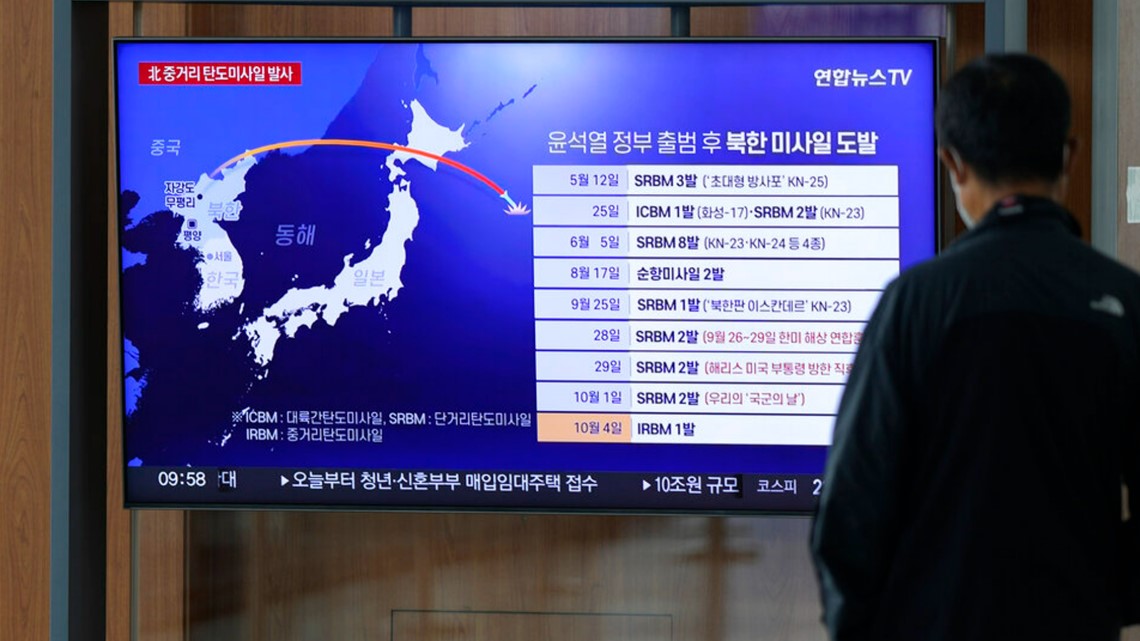The Japanese prime minister’s office said at least one missile fired from North Korea flew over Japan and is believed to have landed in the Pacific Ocean.
SEOUL, South Korea – North Korea on Tuesday fired at a ballistic missile over Japan for the first time in five years, prompting Japan to issue evacuation notices and suspend train services during the flight of a nuclear weapon that could reach the US territory of Guam and beyond.
The launch was North Korea’s most provocative weapons display this year as it ramps up missile tests in its bid to build a full-fledged nuclear arsenal that poses a real threat to US allies and the American homeland and earns the country recognition as a nuclear power.
The United States said it strongly condemned North Korea’s “dangerous and reckless decision” to launch what it called a “long-range ballistic missile” over Japan.
“These actions are destabilizing and demonstrate (North Korea’s) blatant disregard for United Nations Security Council resolutions and international security norms,” it said.
South Korean President Yoon Suk-yeol previously said the missile had an intermediate range, while Japanese Defense Minister Yasukazu Hamada said it was believed to have an intermediate range or more. If Tuesday’s launch involves a long-range missile, it could be a test of a weapon aimed at the U.S. homeland, some experts say.
Japanese authorities warned residents of the northeastern region to evacuate to shelters in the first “J-Alert” warning since 2017, when North Korea fired the Hwasong-12 medium-range missile over Japan twice within weeks during a previous hot streak of weapons tests.
Trains were suspended in the Hokkaido and Aomori regions until the government issued a follow-up message that a North Korean missile appeared to have landed in the Pacific Ocean. In the city of Sapporo, the capital of the prefecture on Japan’s northernmost main island of Hokkaido, the subway was also temporarily suspended and stations crowded with morning commuters.
Japanese Prime Minister Fumio Kishida told reporters that the latest firing “is a reckless act, and I strongly condemn it.”
South Korea’s Joint Chiefs of Staff said the missile was fired from the inner north of North Korea. He warned that the North’s repeated missile launches would only deepen its international isolation and force Seoul and Washington to strengthen their deterrence capabilities.
Yun said the North’s “reckless nuclear provocations” would be met with a strong response from the South and the wider international community.
South Korea and Japan estimate that the missile flew about 4,500-4,600 kilometers (2,800-2,860 miles) at a maximum altitude of 970-1,000 kilometers (600-620 miles). Hamada said the missile fell in the Pacific Ocean, about 3,200 kilometers (1,990 miles) off Japan’s northern coast, and that there were no reports of damage to Japanese aircraft or ships.
Both South Korea and Japan called emergency meetings of the National Security Council to discuss the launch. The US said national security adviser Jake Sullivan had consulted his South Korean and Japanese counterparts about their correct and credible responses.
“The United States will continue its efforts to limit North Korea’s ability to advance its proscribed ballistic missile and weapons of mass destruction programs, including with allies and partners at the United Nations,” said National Security Council spokeswoman Adrienne Watson.
The missile’s range shows the missile has enough range to hit the US Pacific territory of Guam, home to US military bases that have sent advanced warplanes to the Korean peninsula in a show of force during past tense relations with North Korea. In 2017, North Korea threatened to launch “cover fire” near Guam with Hwasong-12 missiles amid growing hostility with the then-Trump administration.
North Korea last launched a Hwasong-12 missile in January. At the time, the North said the launch was to test the overall accuracy of the weapons being deployed by its armed forces. But it is said that the missile was launched at a high angle to prevent it from flying over other countries.
Hamada said the missile launched on Tuesday could have been another Hwasong-12 missile.
Kim Dong-yub, a professor at the University of North Korean Studies in Seoul, said North Korea could have tested the Hwasong-12 again, or even an intercontinental ballistic missile closer to a conventional ballistic trajectory but shorter than its full range. If it were an ICBM, the purpose of the launch would be to test whether the warhead could survive the harsh conditions of reentry, Kim said.
Tuesday’s launch was North Korea’s fifth round of weapons tests in the past 10 days, seen as an apparent response to bilateral military exercises between South Korea and the United States and other drills by allies including Japan last week.
The missiles fired during the last four launches were of short range and landed in the waters between the Korean Peninsula and Japan. These missiles are capable of hitting targets in South Korea.
North Korea has tested about 40 missiles in about 20 different launches this year as its leader Kim Jong-un vows to expand his nuclear arsenal and refuses to return to nuclear diplomacy with the United States. Two of the tests were intercontinental ballistic missiles, but they did not fly over other countries because one was launched at a high angle and the other did not fly at full range.
Some foreign experts say North Korea needs to acquire some remaining technology to acquire operational nuclear missiles. Each new test brings them closer to hitting the US mainland and its allies with multiple nuclear-tipped missiles of varying ranges.
Some experts say Kim will eventually return to diplomacy and use his expanded arsenal to pressure Washington to recognize his country as a nuclear power, a recognition he believes is necessary for the lifting of international sanctions and other concessions.
https://www.wtol.com/article/news/nation-world/n-korea-ballistic-missile-japan/507-a0bc1748-64b0-41ca-b2e1-90c2d8a67442




